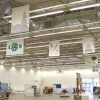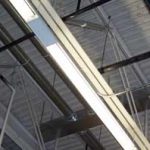Building Information
Location: 5610 Glenwood, Boise, ID 83714
Size: 240,000+ sq. ft. total (Fairground Buildings)
(not including Les Bois Race Track)
Telephone: (208) 287-5650
For More Information: http://www.expoidaho.com/
Lighting Case Study

Download Case Study (pdf)
Prepared and Submitted by Ada County Operations Department;
S. O’Neal and E. Voss
Updated: October 2007
Size: 83,131 sq. ft.
Utilities: Idaho Power and Intermountain Gas
Completion Date: 2008
Type: Exposition Building
Lighting Systems: North and South Wings – T8 fluorescent lamps with electronic ballasts; Central Pavilion – Metal Halide lamps with clerestory
Expo Idaho is the site of Ada County’s annual Western Idaho Fair. The largest building on the fairgrounds is an 83,000 square foot multi-purpose building called the Exposition Building. During the fair, 4-H groups and others use the Expo Building to display their crafts and projects. Throughout the rest of the year, it is rented for a variety of consumer and public events, such as the very popular Home and Garden Show.
This case study looks at the existing T12 lighting system and how it currently operates in its efficiency, performance, and costs. Specifically it examines how a lighting upgrade would provide an energy-efficient, environmentally-friendly lighting solution. It also addresses the basic requirements enacted by Ada County’s Green Building Resolution No. 1180 and United States Federal EPAct 2005.
Currently, the lighting system in the north and south wings of the Expo Building consists mainly of T12 lamps with magnetic ballasts. With the EPAct of 2005, the federal government passed a resolution to phase out magnetic ballasts and replace them with electronic ballasts by 2010. The 2000 Federal Ballast Efficacy Regulations raised the minimum Ballast Efficacy factor for T12 fluorescent ballasts. This includes, among other lamps, the F96T12HO lamps operated on a 120 or 277V ballast which are currently used in the facility.
 Is lighting efficiency really important?
Is lighting efficiency really important?
According to the U.S. Department of Energy, lighting is 31% of energy use in most commercial buildings. The U.S. DOE’s Energy Efficiency and Renewable Energy division has also reported a 40% savings by simply retrofitting T12 lamps and magnetic ballasts with T8 lamps and electronic ballasts.
The lighting seems to be working fine. Why fix what isn’t broken?
Per the EPAct 2005, the phased elimination and sale of most magnetic ballasts in new lighting fixtures will occur in 2009, creating a need for the replacement or retrofitting of lamps that use magnetic ballasts.
 Why not wait to replace the system?
Why not wait to replace the system?
According to the U.S. Economic Census, electronic ballasts represented 47% of ballast sales in 2000 and rose to 57% in 2002. At this rate, magnetic ballasts may already be phased out by 2010 due to consumer market needs. Moreover, magnetic ballasts and T12 lamps are outdated, inefficient technology by today’s standards and do not support the County’s energy needs or sustainable goals.
What are the benefits of a retrofit?
In addition to the economic benefits of reducing energy usage, a lighting system with T8 lamps and electronic ballasts includes increased performance quality, reduced flicker, less noise, and less heat. Fewer heat results in less cooling needed by the air conditioning system. T8s would supply optimal light quality for those who rent and use the space to display work and hold events. Electronic ballasts actually improve the efficacy of T8 lamps by operating them at a much higher frequency, thus requiring less electricity (kWhs) to produce an equal amount of light, further reducing overall energy costs.
 Improved Color Rendering Index (CRI)
Improved Color Rendering Index (CRI)
CRI is a unit of measure that defines how well colors are rendered by different illumination conditions in comparison to a standard such as daylight. CRI is calculated on a scale from 1-100. Low CRI causes colors to appear washed out and even take on a different hue, and high CRI makes all colors look natural and vibrant. A T12 lamp has a CRI of approximately 60 and T8s are typically closer to a CRI of 86. T8s would certainly be a better light for vendors and others who use the facility to display items for sale to the public.
Sustainability
The T12 lamps have a lifecycle of about 12,000 hours. T8s last twice as long with a lifecycle of 24,000 hours. While the cost of the lamps is comparable, T12s are a toxic waste because of their mercury content and cost $0.15 per foot to recycle. The T8 lamp is a non-toxic waste so there are no extra dumping fees associated.
Setting an Example
Looking ahead at the energy costs and sustainability issues the current lighting system poses, updating and installing a more efficient lighting system sets a good example for the public to follow by demonstrating our own policies and sustainable building practices. Ada County works hard to establish and promote an environmental and green standard. This upgrade would serve as a great example and most importantly it adheres to Ada County’s Green Building Resolution No. 1180 and the Federal
EPAct 2005 which require a higher standard of environmental responsibility while providing energy savings.
Incentives
Idaho Power’s Industrial Efficiency Program encourages implementation of energy efficiency measures by offering a financial incentive of $0.12 per annual kWh saved or 50% of project cost, whichever is less.
Recommendation
In order to meet today’s energy standards and our own environmental policies, it makes good business sense to replace outdated lighting with new, energy-efficient products that consume less energy and also improve light quality. Lighting efficiency is usually expressed in lumens per watt. T8 lamps are 17% more efficient than T12s, with an output of 88 lumens per watt versus 73.
Our recommendation is to replace the current T12 fixtures and magnetic ballasts with a wire guarded fixture that holds two tandem T8 fluorescent lamps with electronic ballasts. This protects the lamps during use of the building, reduces the number of fixtures by half, and thereby reduces maintenance. Additional benefits would be improving light quality and ambiance, while reducing operating costs with a more energy-efficient system.
The recommendation is simply a natural migration to upgrade the lighting efficiency based on all of the benefits the new system would offer in the way of increased lamp life, higher lumens per watt, energy savings, and improved lighting quality.
| T12 Annual Purchase and Disposal Costs 12,000 hrs, 160 hrs/mo = 6.25 yrs $3.41/lamp x 408 lamps / 6.25 yrs = |
$222 |
T8 Annual Purchase Costs (no disposal costs) 24,000 hrs, 160 hrs/mo = 12.5 yrs $2.25/lamp x 408 lamps / 12.5 yrs = |
$73 | |
| T12 Magnetic Ballast Annual Replacement Costs $20/ballast + $25/labor x 50/yr = |
$1,270 |
T8 Electronic Ballast Annual Replacement Costs $11.45/ballast + $25/labor x 2/yr |
$61 |
|
| T12 Annual Operating Costs 4080 kWh/mo x $.05 x 12 = |
$4,896 $6,389 |
Annual Savings |
$4,295 |
|
| Actual Project Costs incurred in 2008 (not including labor) T8 8′ Shielded Fixtures w/ Electronic Ballasts Idaho Power Incentive |
$21,294 -14,800 $ 6,494 |
|||
| Payback | 2 years |
